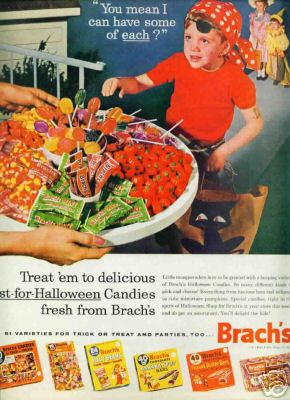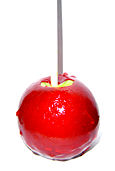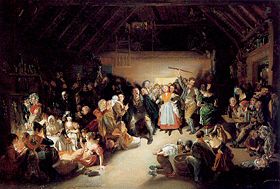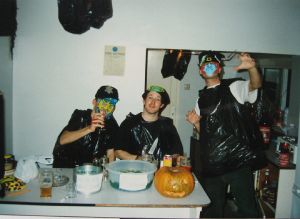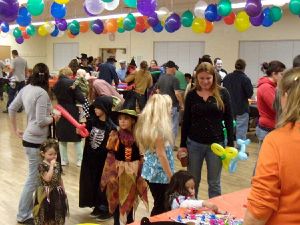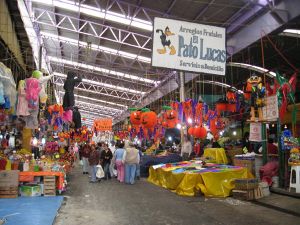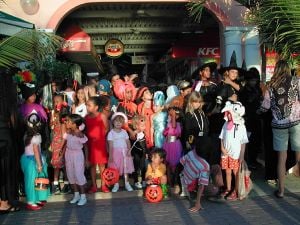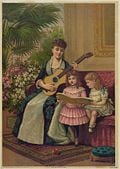Difference between revisions of "Halloween" - New World Encyclopedia
| Line 192: | Line 192: | ||
Halloween is significant event in Ireland where it is widely celebrated. It is known in Irish as ''Oíche Shamhna'' (pronounced ''ee-hah how-nah''), literally "Samhain Night." Pre-Christian Celts had an autumn festival, Samhain ([[Irish phonology|pronounced]] {{IPA|/ˈsˠaunʲ/from the [[Old Irish]] ˈˈsamainˈˈ}}), "End of Summer," a pastoral and agricultural "fire festival" or feast, when the dead revisited the mortal world and large communal bonfires would hence be lit to ward off evil spirits. | Halloween is significant event in Ireland where it is widely celebrated. It is known in Irish as ''Oíche Shamhna'' (pronounced ''ee-hah how-nah''), literally "Samhain Night." Pre-Christian Celts had an autumn festival, Samhain ([[Irish phonology|pronounced]] {{IPA|/ˈsˠaunʲ/from the [[Old Irish]] ˈˈsamainˈˈ}}), "End of Summer," a pastoral and agricultural "fire festival" or feast, when the dead revisited the mortal world and large communal bonfires would hence be lit to ward off evil spirits. | ||
| − | + | On Halloween night, adults and children dress up as creatures from the [[underworld]] (e.g., ghosts, ghouls, zombies, witches, and goblins), light bonfires, and enjoy spectacular fireworks displays—in particular, the city of [[Derry]] is home to the largest organized Halloween celebration on the island, in the form of a street carnival and fireworks display.<ref>{{cite web|url=http://www.derrycity.gov.uk/halloween/ |title=Halloween 2007 |publisher=Derrycity.gov.uk |date= |accessdate=2008-10-31}}</ref> It is also common for fireworks to be set off for the entire month preceding Halloween as well as a few days after. Halloween was perceived as the night during which the division between the world of the living and the otherworld was blurred so that spirits of the dead and inhabitants from the underworld were able to walk free on the earth. | |
| − | + | [Image:IMG 145w.jpg|thumb|250px|right|Typical Halloween scene in Dublin, Ireland.]] | |
| − | + | Houses are frequently adorned with pumpkins or [[turnips]] carved into scary faces; lights or candles are sometimes placed inside the carvings, resulting in an eerie effect. The traditional Halloween cake in Ireland is the [[barmbrack]], which is a fruit bread. The Halloween Brack traditionally contained various objects baked into the bread and was used as a [[fortune-telling]] game. In the barmbrack were a pea, a stick, a piece of cloth, a small coin (originally a silver sixpence), and a ring. Commercially produced barmbracks for the Halloween market still include a toy ring. Games are often played, such as bobbing for apples, in which apples, peanuts, and other nuts and fruit and some small coins are placed in a basin of water. Games of divination are also played at Halloween, but are becoming less popular | |
| − | |||
| − | On Halloween night, adults and children dress up as creatures from the [[underworld]] (e.g., ghosts, ghouls, zombies, witches, and goblins), light bonfires, and enjoy spectacular fireworks displays—in particular, the city of [[Derry]] is home to the largest organized Halloween celebration on the island, in the form of a street carnival and fireworks display.<ref>{{cite web|url=http://www.derrycity.gov.uk/halloween/ |title=Halloween 2007 |publisher=Derrycity.gov.uk |date= |accessdate=2008-10-31}}</ref> It is also common for fireworks to be set off for the entire month preceding Halloween as well as a few days after. Halloween was perceived as the night during which the division between the world of the living and the otherworld was blurred so that spirits of the dead and inhabitants from the underworld were able to walk free on the earth. | ||
| − | |||
| − | Houses are frequently adorned with pumpkins or [[turnips]] carved into scary faces; lights or candles are sometimes placed inside the carvings, resulting in an eerie effect. The traditional Halloween cake in Ireland is the [[barmbrack]], which is a fruit bread. The Halloween Brack traditionally contained various objects baked into the bread and was used as a [[fortune-telling]] game. In the barmbrack were a pea, a stick, a piece of cloth, a small coin (originally a silver sixpence), and a ring | ||
| − | |||
| − | Games are often played, such as bobbing for apples, in which apples, peanuts, and other nuts and fruit and some small coins are placed in a basin of water. | ||
| − | |||
| − | |||
===Scotland=== | ===Scotland=== | ||
Revision as of 14:11, 15 February 2009
| Halloween Hallowe'en | |
|---|---|
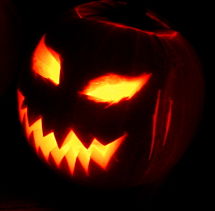
| |
| Jack-o'-lantern | |
| Also called | All Hallows Eve All Saints' Eve |
| Observed by | Numerous Western countries (see article) |
| Type | Secular with roots in Christianity and Paganism |
| Date | October 31 |
| Celebrations | Varies by region but includes trick-or-treating, ghost tours, apple bobbing, costume parties, carving jack-o'-lanterns |
| Related to | Samhain, All Saints Day |
Halloween (or Hallowe’en) is a holiday celebrated on October 31. It has roots in the Celtic festival of Samhain and the Christian holy day of All Saints. It is largely a secular celebration, but some Christians and Pagans have expressed strong feelings about its religious overtones.[1][2][3] Irish immigrants carried versions of the tradition to North America during Ireland's Great Famine of 1846.[4] The day is often associated with the colors orange and black, and is strongly associated with symbols such as the jack-o'-lantern. Halloween activities include trick-or-treating, ghost tours, bonfires, costume parties, visiting haunted attractions, carving jack-o'-lanterns, reading scary stories, and watching horror movies.
History
Halloween has origins in the ancient Celtic festival known as Samhain (Template:IPAga; from the Old Irish samain, apparently derived from Gaulish samonios).[5] The festival of Samhain is a celebration of the end of the harvest season in Gaelic culture, and is sometimes[6] regarded as the "Celtic New Year".[7] Traditionally, the festival was a time used by the ancient Celtic pagans to take stock of supplies and slaughter livestock for winter stores. The ancient Celts believed that on October 31, now known as Halloween, the boundary between the living and the deceased dissolved, and the dead become dangerous for the living by causing problems such as sickness or damaged crops. The festivals would frequently involve bonfires, into which the bones of slaughtered livestock were thrown. Costumes and masks were also worn at the festivals in an attempt to copy the evil spirits or placate them.[8][9]
Origin of name
The term Halloween is shortened from All Hallows' Even (both "even" and "eve" are abbreviations of "evening," but "Halloween" gets its "n" from "even") as it is the eve of "All Hallows' Day",[10] which is now also known as All Saints' Day. It was a day of religious festivities in various northern European Pagan traditions,[11] until Popes Gregory III and Gregory IV moved the old Christian feast of All Saints' Day from May 13 (which had itself been the date of a pagan holiday, the Feast of the Lemures) to November 1. In the ninth century, the Church measured the day as starting at sunset, in accordance with the Florentine calendar. Although All Saints' Day is now considered to occur one day after Halloween, the two holidays were, at that time, celebrated on the same day.
Symbols
On Hallows' eve, the ancient Celts would place a skeleton on their window sill to represent the departed. Originating in Europe, these lanterns were first carved from a turnip or rutabaga. Believing that the head was the most powerful part of the body, containing the spirit and the knowledge, the Celts used the "head" of the vegetable to frighten off any superstitions.[12] Welsh, Irish and British myth are full of legends of the Brazen Head, which may be a folk memory of the widespread ancient Celtic practice of headhunting - the results of which were often nailed to a door lintel or brought to the fireside to speak their wisdom. The name jack-o'-lantern can be traced back to the Irish legend of Stingy Jack,[13] a greedy, gambling, hard-drinking old farmer. He tricked the devil into climbing a tree and trapped him by carving a cross into the tree trunk. In revenge, the devil placed a curse on Jack, condemning him to forever wander the earth at night with the only light he had: a candle inside of a hollowed turnip. The carving of pumpkins is associated with Halloween in North America,[14] where pumpkins were not only readily available but much larger, making them easier to carve than turnips. Many families that celebrate Halloween carve a pumpkin into a frightening or comical face and place it on their doorstep after dark. In America, the tradition of carving pumpkins is known to have preceded the Great Famine period of Irish immigration.[citation needed] The carved pumpkin was originally associated with harvest time in general, in America and did not become specifically associated with Halloween until the mid-to-late 19th century.[citation needed]
The imagery surrounding Halloween is largely an amalgamation of the Halloween season itself, works of Gothic and horror literature, nearly a century of work from American filmmakers and graphic artists,[15] and a rather commercialized take on the dark and mysterious. Halloween imagery tends to involve death, evil, magic, or mythical monsters. Traditional characters include the Devil, the Grim Reaper, ghosts, ghouls, demons, witches, pumpkin-men, goblins, vampires, werewolves, zombies, mummies, skeletons, black cats, spiders, bats, owls, crows, and vultures.[16]
Particularly in America, symbolism is inspired by classic horror films (which contain fictional figures like Frankenstein's monster and The Mummy), and to a lesser extent by science fiction (aliens, UFOs, and superheroes). Elements of the autumn season, such as pumpkins, corn husks, and scarecrows, are also prevalent. Homes are often decorated with these types of symbols around Halloween.
The three main colors associated with Halloween are pumpkin orange, night or death black, and moon, ghost or skeleton white.[17]
Trick-or-treating and guising
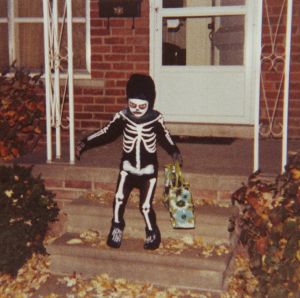
Trick-or-treating is a custom for children on Halloween. Children proceed in costume from house to house, asking for treats such as confectionery, or sometimes money, with the question, "Trick or treat?" The "trick" is an idle threat to perform mischief on the homeowners or their property if no treat is given.
In the United States, trick-or-treating is now one of the main traditions of Halloween and it has become socially expected that if one lives in a neighborhood with children one should purchase treats in preparation for trick-or-treaters. The National Confectioners Association reported in 2005 that 80 percent of adults in the United States planned to give out confectionery to trick-or-treaters,[18] and that 93 percent of children planned to go trick-or-treating.[19] The tradition has also spread to Britain, Ireland, and other European countries, where similar native traditions have been influenced by the American Halloween customs.
Origin
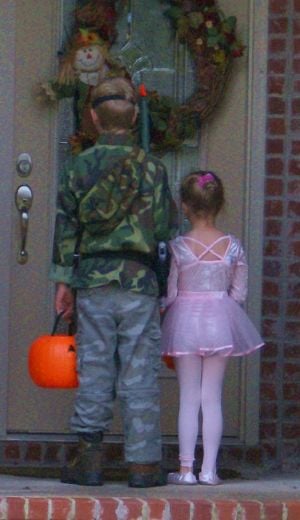
The practice of dressing up in costumes and begging door to door for treats on holidays dates back to the Middle Ages and includes Christmas wassailing. Trick-or-treating resembles the late medieval practice of souling, when poor folk would go door to door on Hallowmas (November 1), receiving food in return for prayers for the dead on All Souls Day (November 2). It originated in Ireland and Britain,[20] although similar practices for the souls of the dead were found as far south as Italy.[21] Shakespeare mentions the practice in his comedy The Two Gentlemen of Verona (1593), when Speed accuses his master of "puling [whimpering or whining] like a beggar at Hallowmas."[22]
However, there is no evidence that souling was ever practiced in North America, where trick-or-treating may have developed independent of any Irish or British antecedent. There is little primary documentation of masking or costuming on Halloween—in Ireland, the UK, or America—before 1900.[23] Ruth Edna Kelley, in her 1919 history of the holiday, The Book of Hallowe'en, makes no mention of ritual begging in the chapter "Hallowe'en in America."[24] Kelley lived in Lynn, Massachusetts, a town with about 4,500 Irish immigrants, 1,900 English immigrants, and 700 Scottish immigrants in 1920.[25] The thousands of Halloween postcards produced between the turn of the 20th century and the 1920s commonly show children but do not depict trick-or-treating.[26] The editor of a collection of over 3,000 vintage Halloween postcards writes,
There are cards which mention the custom [of trick-or-treating] or show children in costumes at the doors, but as far as we can tell they were printed later than the 1920s and more than likely even the 1930s. Tricksters of various sorts are shown on the early postcards, but not the means of appeasing them.[27]
Thus, although a quarter million Scots-Irish immigrated to America between 1717 and 1770, the Irish Potato Famine brought more than a million immigrants to North America in 1845–1849,[28] and British and Irish immigration to America peaked in the 1880s,[29] ritualized begging on Halloween was virtually unknown in America until generations later.
The earliest known reference to ritual begging on Halloween in English speaking North America occurs in 1911, when a newspaper in Kingston, Ontario, near the border of upstate New York, reported that it was normal for the smaller children to go street guising (see below) on Halloween between 6 and 7 p.m., visiting shops and neighbors to be rewarded with nuts and candies for their rhymes and songs.[30] Another isolated reference to ritual begging on Halloween appears, place unknown, in 1915, with a third reference in Chicago in 1920.[31]
The earliest known use in print of the term "trick or treat" appears in 1927, from Blackie, Alberta, Canada:
Hallowe’en provided an opportunity for real strenuous fun. No real damage was done except to the temper of some who had to hunt for wagon wheels, gates, wagons, barrels, etc., much of which decorated the front street. The youthful tormentors were at back door and front demanding edible plunder by the word “trick or treat” to which the inmates gladly responded and sent the robbers away rejoicing.[32]
Trick-or-treating does not seem to have become a widespread practice until the 1930s, with the first U.S. appearances of the term in 1934,[33] and the first use in a national publication occurring in 1939.[34]
Increased popularity
Almost all pre-1940 uses of the term "trick-or-treat" are from the western United States and Canada.[35] Trick-or-treating spread from the western United States eastward, stalled by sugar rationing that began in April 1942 during World War II and did not end until June 1947.[36]
Early national attention to trick-or-treating was given in October 1947 issues of the children's magazines Jack and Jill and Children's Activities,[37] and by Halloween episodes of the network radio programs The Baby Snooks Show in 1946 and The Jack Benny Show and The Adventures of Ozzie and Harriet in 1948.[38] The custom had become firmly established in popular culture by 1952, when Walt Disney portrayed it in the cartoon Trick or Treat, Ozzie and Harriet were besieged by trick-or-treaters on an episode of their television show,[39] and UNICEF first conducted a national campaign for children to raise funds for the charity while trick-or-treating.[40]
Although some popular histories of Halloween have characterized trick-or-treating as an adult invention to rechannel Halloween activities away from vandalism, nothing in the historical record supports this theory. To the contrary, adults, as reported in newspapers from the mid-1930s to the mid-1950s, typically saw it as a form of extortion, with reactions ranging from bemused indulgence to anger.[41] Likewise, as portrayed on radio shows, children would have to explain what trick-or-treating was to puzzled adults, and not the other way around. Sometimes even the children protested: for Halloween 1948, members of the Madison Square Boys Club in New York City carried a parade banner that read "American Boys Don't Beg."[42]
Introduction to the UK
Before the 1980s, trick-or-treating in its American form was little known in the UK and when introduced was often regarded as an unusual and even unwelcome import, but the influence of American popular culture caused it to rapidly take hold, to the extent that one British reporter has called it "the Japanese knotweed of festivals".[43]
Local variants
In Ireland guising is traditional, and the American jocular threat is not practiced, just "treats" (in the form of "apples or nuts for the Halloween party") given out to the children dressed up as ghosts and witches. Up until circa 1960 children used unusual clothing and face make-up for stunning effect,[citation needed] but with the growing commercialism, theme masks and theme outfits became more popular. In 19th and early 20th century Ireland the costuming was often much more extravagant—for example, slates were placed over the chimney-pots of houses filling the rooms with smoke and field gates were lifted off their hinges and hung from high tree branches.[citation needed]
Until the 1990s, Irish children said "Help the Halloween Party," but are now more inclined to use the American "Trick or treat" due to the influence of American popular culture, movies, and television. In Waterford, the phrase "attin far Halloween" is still commonly used, being the vernacular pronunciation of "anything for Halloween".[citation needed]
In Quebec, Canada, children also go door to door on Halloween. However, in French speaking neighbourhoods, instead of "Trick or treat?," they will simply say "Halloween," though in tradition it used to be La charité s'il-vous-plaît ("Charity, please").[citation needed]
In Ohio, Iowa, and Massachusetts, the night designated for Trick-or-treating is referred to as Beggars Night since moving the date from Halloween in a successful effort to end the vandalism that had often accompanied Halloween activities.[citation needed]
In Sweden children dress up as witches and go trick-or-treating on Maundy Thursday (the Thursday before Easter) while Danish children dress up in various attires and go trick-or-treating on Fastelavn (or the next day, Shrove Monday)and In Norway kids go trick-or-treating between Christmas and New Year's Eve. In parts of Flanders and some parts of the Netherlands and most areas of Germany and Austria, children go to houses with home made beet lanterns or with paper lanterns (which can hold a candle or electronic light), singing songs about St. Martin on St. Martin's Day (the 11th of November), in return for treats.[citation needed]
Children of the St. Louis, Missouri and Des Moines, Iowa area are expected to perform a joke before receiving any candy.[44][45]
Guising
In Scotland and parts of northern England, a similar tradition is called guising because of the disguise or costume worn by the children. Although traditions of seasonal guising stretch back at least as far as the Middle Ages,[46] it became an exclusively Halloween practice only in the twentieth century. However there is a significant difference from the way the practice has developed in the United States. In Scotland, the children are only supposed to receive treats if they perform for the households they go to. This normally takes the form of singing a song or reciting a joke or a funny poem which the child has memorized before setting out. Occasionally a more talented child may do card tricks, play the mouth organ, or something even more impressive, but most children will earn plenty of treats even with something very simple. However, guising is falling out of favour somewhat, being replaced in some parts of the country with the American form of trick-or-treating. Such a practice is in use in certain regions of the United States, as well.
Costumes
Halloween costumes are traditionally those of monsters such as ghosts, skeletons, witches, and devils. Costumes are also based on themes other than traditional horror, such as those of characters from television shows, movies, and other pop culture icons.
Costume sales
BIGresearch conducted a survey for the National Retail Federation in the United States and found that 53.3% of consumers planned to buy a costume for Halloween 2005, spending $38.11 on average (up $10 from the year before). They were also expected to spend $4.96 billion in 2006, up significantly from just $3.3 billion the previous year.[47]
UNICEF
"'Trick-or-Treat for UNICEF" has become a common sight during Halloween in North America. Started as a local event in a Philadelphia suburb in 1950 and expanded nationally in 1952, the program involves the distribution of small boxes by schools (or in modern times, corporate sponsors like Hallmark, at their licensed stores) to trick-or-treaters, in which they can solicit small-change donations from the houses they visit. It is estimated that children have collected more than $119 million (US) for UNICEF since its inception. In 2006, UNICEF discontinued their Halloween collection boxes in parts of the world, citing safety and administrative concerns.[48]
Games and other activities
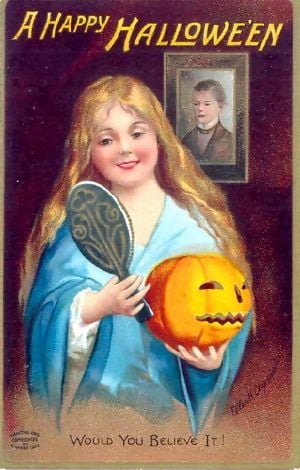
There are several games traditionally associated with Halloween parties. The most common[citation needed] is dunking or apple bobbing, in which apples float in a tub or a large basin of water; the participants must use their teeth to remove an apple from the basin. A variant of dunking involves kneeling on a chair, holding a fork between the teeth and trying to drop the fork into an apple. Another common game involves hanging up treacle or syrup-coated scones by strings; these must be eaten without using hands while they remain attached to the string, an activity that inevitably leads to a very sticky face.
Some games traditionally played at Halloween are forms of divination. In Puicíní (pronounced "poocheeny"), a game played in Ireland, a blindfolded person is seated in front of a table on which several saucers are placed. The saucers are shuffled, and the seated person then chooses one by touch; the contents of the saucer determine the person's life during the following year. In 19th-century Ireland, young women placed slugs in saucers sprinkled with flour.[citation needed] A traditional Irish and Scottish form of divining one's future spouse is to carve an apple in one long strip, then toss the peel over one's shoulder. The peel is believed to land in the shape of the first letter of the future spouse's name. This custom has survived among Irish and Scottish immigrants in the rural United States.[citation needed]
Unmarried women were frequently told[attribution needed] that if they sat in a darkened room and gazed into a mirror on Halloween night, the face of their future husband would appear in the mirror. However, if they were destined to die before marriage, a skull would appear. The custom was widespread enough to be commemorated on greeting cards from the late 19th and early 20th centuries.[citation needed]
The telling of ghost stories and viewing of horror films are common fixtures of Halloween parties. Episodes of TV series and specials with Halloween themes (with the specials usually aimed at children) are commonly aired on or before the holiday, while new horror films, are often released theatrically before the holiday to take advantage of the atmosphere.
Haunted attractions
Haunted attractions are entertainment venues designed to thrill and scare patrons; most are seasonal Halloween businesses. Origins of these paid scare venues are difficult to pinpoint, but it is generally accepted that they were first commonly used by the Jaycees for fundraising.[49] They include haunted houses, corn mazes, and hayrides,[50] and the level of sophistication of the effects has risen as the industry has grown. Haunted attractions in the United States bring in an estimate $300-500 million each year, and draw some 400,000 customers, although trends suggest a peak in 2005[49]. This increase in interest has led to more highly technical special effects and costuming that is comparable with that in Hollywood films.[51]
Foods
Because the holiday comes in the wake of the annual apple harvest, candy apples (also known as toffee, caramel or taffy apples) are a common Halloween treat made by rolling whole apples in a sticky sugar syrup, sometimes followed by rolling them in nuts.
At one time, candy apples were commonly given to children, but the practice rapidly waned in the wake of widespread rumors that some individuals were embedding items like pins and razor blades in the apples.[52] While there is evidence of such incidents,[53] they are quite rare and have never resulted in serious injury. Nonetheless, many parents assumed that such heinous practices were rampant. At the peak of the hysteria, some hospitals offered free x-rays of children's Halloween hauls in order to find evidence of tampering. Virtually all of the few known candy poisoning incidents involved parents who poisoned their own children's candy, and there have been occasional reports of children putting needles in their own (and other children's) candy in need of a bit of attention.
One custom that persists in modern-day Ireland is the baking (or more often nowadays, the purchase) of a barmbrack (Irish "báirín breac"), which is a light fruitcake, into which a plain ring, a coin and other charms are placed before baking. It is said that those who get a ring will find their true love in the ensuing year. This is similar to the tradition of king cake at the festival of Epiphany.
Other foods associated with the holiday:
- Candy corn
- Báirín Breac (Ireland)
- Colcannon (Ireland)
- Bonfire toffee (in the UK)
- Toffee Apple (Australia when celebrated, England, Wales and Scotland, instead of "Candy Apples")
- Apple cider
- Cider
- Roasted sweetcorn
- Popcorn
- Roasted pumpkin seeds
- Pumpkin pie and pumpkin bread
- "Fun-sized" or individually wrapped pieces of small candy, typically in Halloween colors of orange, and brown/black.
- Novelty candy shaped like skulls, pumpkins, bats, worms, etc.
- Small bags of potato chips, pretzels and caramel corn
- Chocolates, caramels, and gum
- Nuts
Around the world
Halloween is not celebrated in all countries and regions of the world, but among those that do that traditions and importance of the celebration varies significantly. The celebrations in the United States have had a significant impact on how the holiday is observed in other nations. The history of Halloween traditions in a given country lends context to how it is presently celebrated.
Halloween is a holiday observed on October 31, primarily in regions of the Western world. The festival has its roots in Ireland, and was popularized after Irish immigrants brought it to the United States in 1846.[4]
Ireland
Halloween is significant event in Ireland where it is widely celebrated. It is known in Irish as Oíche Shamhna (pronounced ee-hah how-nah), literally "Samhain Night." Pre-Christian Celts had an autumn festival, Samhain (pronounced /ˈsˠaunʲ/from the Old Irish ˈˈsamainˈˈ), "End of Summer," a pastoral and agricultural "fire festival" or feast, when the dead revisited the mortal world and large communal bonfires would hence be lit to ward off evil spirits.
On Halloween night, adults and children dress up as creatures from the underworld (e.g., ghosts, ghouls, zombies, witches, and goblins), light bonfires, and enjoy spectacular fireworks displays—in particular, the city of Derry is home to the largest organized Halloween celebration on the island, in the form of a street carnival and fireworks display.[54] It is also common for fireworks to be set off for the entire month preceding Halloween as well as a few days after. Halloween was perceived as the night during which the division between the world of the living and the otherworld was blurred so that spirits of the dead and inhabitants from the underworld were able to walk free on the earth. [Image:IMG 145w.jpg|thumb|250px|right|Typical Halloween scene in Dublin, Ireland.]] Houses are frequently adorned with pumpkins or turnips carved into scary faces; lights or candles are sometimes placed inside the carvings, resulting in an eerie effect. The traditional Halloween cake in Ireland is the barmbrack, which is a fruit bread. The Halloween Brack traditionally contained various objects baked into the bread and was used as a fortune-telling game. In the barmbrack were a pea, a stick, a piece of cloth, a small coin (originally a silver sixpence), and a ring. Commercially produced barmbracks for the Halloween market still include a toy ring. Games are often played, such as bobbing for apples, in which apples, peanuts, and other nuts and fruit and some small coins are placed in a basin of water. Games of divination are also played at Halloween, but are becoming less popular
Scotland
Scotland, having a shared Gaelic culture with Ireland, has celebrated the festival of Samhain (pronounced Sow-win) robustly for many centuries. The autumn festival is pre-Christian Celtic in origin, and is known in Scottish Gaelic as Oidhche Shamhna, the “Summer's night.” During the fire festival, souls of the dead wander the Earth and are free to return to the mortal world until dawn. Traditionally, bonfires and lanterns (samhnag in Scottish Gaelic) would be lit to ward off the phantoms and evil spirits that emerge at midnight. The term Samhainn or Samhuinn is used for the harvest feast, and an t-Samhain is used for the entire month of November.
History
As in Ireland, the exact customs involved with celebrating Halloween from ancient times to preindustrialised Scotland are lost and lack primary documentation to distinguish the ancient customs from the modern counterpart. The Witchcraft Act of 1735 contained a clause preventing the consumption of pork and pastry comestibles on Halloween,[citation needed] although in modern times, such treats are popular with children. The act was repealed in the 1950s. Scotland's National Bard, Robert Burns, portrayed the varied custom for children to dress up in costumes in his poem "Hallowe'en" (1785).[citation needed]
Halloween was seen as the time when the division between the world of the living and the otherworld was blurred. Many of the traditional customs derive from ancient divination practices and ways of trying to predict the future. By the 18th century, most of the customs were methods for young people to search for their future husbands or wives. As Samhainn was originally a harvest festival, many of these practices are connected with food or the harvest and fertility. One old custom associated with the Western Isles was to put two large nuts in the hearth of a peat fire to represent the person and his or her intended spouse. If the nuts curled together when they warmed up, it was deemed to be a good omen; but if they jumped apart, then it was time to look for another sweetheart.[citation needed] Islanders from Lewis traditionally poured ale into the sea as a libation to a marine God called “Seonaidh,” or “Shoney,” on Celtic Samhain or Halloween so that he would send seaweed to the shore to fertilise the fields for the coming year. Seonadh in Scottish Gaelic means sorcery, augury, or Druidism, and it is possible that the custom of Shonaidh is the direct link to an ancient form of Celtic god worship that has been Christianised.[citation needed] As "Seonaidh," which is Gaelic "Johnny," it may also be a reference to one of St. John and an invocation of him.
Fire rituals were also important. Great bonfires were lit in villages or by individual families, with the resultant ashes being used to form a circle. One stone for each member of the household was kept inside this circle near the circumference. If any stone were displaced or seemed broken by next morning, the person to whom that stone belonged was believed to be destined to die within a year.[citation needed] A similar rite in northern Wales includes a great bonfire called Coel Coeth, built for each family on Halloween; later, the members of the household threw a white stone marked in their name into the ashes. Upon the next morning, all the stones were searched for, and if any stone was missing, the person who threw that stone was believed to be destined to die before next Halloween.[citation needed] In particular, the village of Fortingall, in Perthshire, held festivities on Carn na Marbh, "Mound of the Dead." This was the focal point of a Samhain festival. A great fire, or “Samhnag,” was lit atop it each year. The whole community took hands when it was blazing and danced around the mound, both sunwise and antisunwise.[55] As the fire began to wane, some of the younger boys took burning embers from the flames and ran throughout the field with them, finally throwing them into the air and dancing over them as they lay glowing on the ground. When the last embers were showing, the boys would have a leaping competition across the remains of the fire, reminiscent of the Beltane festival. When it was finished, the young people went home to duck for apples and practise divination. There was no Scottish tradition of "guising" here, the bonfire being the absolute centre of attention until it was consumed. The Samhain celebrations here apparently came to an end relatively early, in 1925.
Traditions
In Scotland, folklore, including that of Halloween, revolves around the ancient Celtic belief in faeries (Sidhe, or Sith, in modern Gaelic). Children who ventured out carried a traditional lantern (samhnag) with a devil face carved into it to frighten away the evil spirits. Such Halloween lanterns were made from a turnip, or “Neep” in “Lowland Scots,” with a candle lit in the hollow inside. In modern times, however, such lanterns use pumpkins, as in North American traditions, possibly because it is easier to carve a face into a pumpkin than into a turnip. Due to this, the practice of hollowing out pumpkins into jack-o'-lanterns may have its roots in this practice.
Houses were also protected with the same candle lanterns. If the spirits got past the protection of the lanterns, the Scottish custom was to offer the spirits parcels of food to leave and spare the house another year. Children, too, were given the added protection by disguising them as such creatures in order to blend in with the spirits. If children approached the door of a house, they were also given offerings of food (Halloween being a harvest festival), which served to ward off the potential spirits that may lurk among them. This is where the origin of the practice of Scottish “guising” (a word that comes from "disguising"), or going about in costume, arose. It is now a key feature of the tradition of trick-or-treating practised in North America.
In modern-day Scotland, this old tradition survives, chiefly in the form of children going door to door "guising" in this manner; that is, dressed in a disguise (often as a witch, ghost, monster, or another supernatural being) and offering entertainment of various sorts. If the entertainment is enjoyed, the children are rewarded with gifts of sweets, fruits, or money. There is no Scottish trick-or-treat tradition as in North America; on the contrary, trick or treating is an outgrowth of these Scottish guising customs.[citation needed]
Popular games played on the holiday include "dooking" for apples (i.e., retrieving an apple from a bucket of water using only one's mouth). In some places, the game has been replaced (because of fears of contracting saliva-borne illnesses in the water) by standing over the bowl holding a fork in one's mouth and releasing it in an attempt to skewer an apple using only gravity. Another popular game is attempting to eat, while blindfolded, a treacle- or jam-coated scone on a piece of string hanging from the ceiling. Sometimes the blindfold is left out, because it is already difficult to eat the scone. In all versions, however, the participants cannot use their hands.
In 2007, Halloween festival organisers in Perthshire said they wanted to move away from U.S.-style celebrations in favour of more culturally accurate traditions. Plans include abandoning the use of pumpkins and reinstating traditional activities, such as a turnip lantern competition and dooking (ducking) for apples.[56]
Isle of Man
The Manx traditionally celebrate Hop-tu-Naa on October 31; this ancient Celtic tradition has parallels in Scottish and Irish traditions.
England
History
All Saints' Day (All Hallows Day) became fixed on 1 November in 835, and All Souls' Day on 2 November, circa 998. On All Souls' Eve, families stayed up late, and little "soul cakes" were eaten by everyone. At the stroke of midnight, there was solemn silence among households, which had candles burning in every room to guide the souls back to visit their earthly homes and a glass of wine on the table to refresh them. The tradition continued in areas of northern England as late as the 1930s, with children going from door to door "souling" (i.e., singing songs) for cakes or money. The English Reformation in the 16th century de-emphasised holidays like All Hallows Day or All Souls Day and their associated eves.
Traditions
In parts of northern England, there is a traditional festival called Mischief Night, which falls on the 30th of October. During the celebration, children play a range of "tricks" (ranging from minor to more serious) on adults. One of the more serious tricks might include the unhinging of garden gates (which were often thrown into ponds or moved far away). In recent years, such acts have occasionally escalated to extreme vandalism, sometimes involving street fires.[57]
Halloween celebrations in England were popularised in the late 20th century under the pressure of American cultural influence, including a stream of films and television programmes aimed at children and adolescents and the discovery by retail experts of a marketing opportunity to fill the empty space before Christmas. Between 2001 and 2006, consumer spending in the UK for Halloween rose tenfold, from £12 m to £120 m, according to Bryan Roberts from industry analysts Planet Retail, making Halloween the third most profitable holiday for supermarkets.[58] This led to the introduction of practises such as pumpkin carving and trick-or-treat. One of the earliest references to trick or treating in Britain comes from a House of Lords debate in 1986, when it was described as a recently imported custom: the substance of the debate was the concern that youths were using trick or treating to obtain money from old people and others, or threatening nasty tricks. [59]. In England and Wales, trick-or-treating does still occur, although the practice is regarded by some as a nuisance or even a menacing form of begging.[60]
Bobbing for apples is a well-established association with Halloween. In the game, attempts are made (using only one's mouth) to catch an apple placed in a water-filled barrel. Once an apple is caught, it is sometimes peeled and tossed over the shoulder in the hope that the strips would fall into the shape of a letter, which would be the first initial of the participant's true love.[citation needed]
Other traditions include making toffee apples and apple tarts. Apple tarts may be baked with a coin hidden inside, and nuts of all types are traditional Halloween fare.
There has been increasing concern about the potential for antisocial behaviour, particularly among older teenagers, on Halloween. Cases of houses being "egg-bombed" or having lit fireworks posted through the letterbox (especially when the occupants do not give money or gifts) have been reported, and the BBC reported that for Halloween 2006, police forces stepped up patrols to respond to such mischief.[61]
Wales
In Welsh, Halloween is known as Nos Calan Gaeaf (the beginning of the new winter; see Calan Gaeaf). Spirits are said to walk around (as it is an Ysbrydnos, or "spirit night"), and a "white lady" ghost is sometimes said to appear. Bonfires are lit on hillsides to mark the night.
Customs
- Coelcerth: Families build a fire and place stones with their names on it. The person whose stone is missing the next morning would die within the year.
- Yr Hwch Ddu Gwta: Legend has it that a fearsome spirit called Yr Hwch Ddu Gwta took the form of a tail-less black sow and roamed the countryside with a headless woman. Children would rush home early.
- Eiddiorwg Dalen: A few leaves of ground ivy is thought to give you the power to see hags. For prophetic dreams a boy should cut ten ivy leaves, throw away one and put the rest under his head before he sleeps. A girl should take a wild rose grown into a hoop, creep through it three times, cut it in silence, and go to bed with it under her pillow.
- Teiliwr: In Glamorgan tailors were associated with witchcraft. They supposedly possessed the power to ‘bewitch’ anybody if they wished.
United States and Canada
History
Halloween did not become a holiday in the United States until the 19th century, where lingering Puritan tradition restricted the observance of many holidays. American almanacs of the late 18th and early 19th centuries do not include Halloween in their lists of holidays.[62] The transatlantic migration of nearly two million Irish following the Irish Potato Famine (1845–1849) finally brought the holiday to the United States. Scottish emigration, primarily to Canada before 1870 and to the United States thereafter, brought the Scottish version of the holiday to each country. The main event for children of modern Halloween in the United States and Canada is trick-or-treating, in which children disguise themselves in costumes and go door to door in their neighborhoods, ringing each doorbell and yelling "Trick or treat!" to solicit a gift of candy or similar items.[63]
Irish-American and Scottish-American societies held dinners and balls that celebrated their heritages, with perhaps a recitation of Robert Burns' poem "Halloween" or a telling of Irish legends, much as Columbus Day celebrations were more about Italian-American heritage than Columbus per se. Home parties centred on children's activities, such as apple bobbing, and various divination games often concerning future romance. Not surprisingly, pranks and mischief were common as well.
At the turn of the 20th century, Halloween had turned into a night of vandalism, with destruction of property and cruelty to animals and people.[64] Around 1912, the Boy Scouts, Boys Clubs, and other neighborhood organizations came together to encourage a safe celebration that would end the destruction that had become so common on this night.[65] School posters during this time called for a "Sane Halloween." Children began to go door to door, receiving treats, rather than playing tricks on their neighbors. This helped to reduce the mischief, and by the 1930s, "beggar's nights" had become very popular. Trick-or-treating became widespread by the end of the 1930s.
Traditions
The commercialization of Halloween in the United States did not start until the 20th century, beginning perhaps with Halloween postcards (featuring hundreds of designs), which were most popular between 1905 and 1915.[66] Dennison Manufacturing Company (which published its first Halloween catalog in 1909) and the Beistle Company were pioneers in commercially made Halloween decorations, particularly die-cut paper items.[67][68] German manufacturers specialised in Halloween figurines that were exported to the United States in the period between the two World Wars.
There is little primary documentation of masking or costuming on Halloween in the United States or elsewhere before 1900.[69] Mass-produced Halloween costumes did not appear in stores until the 1930s, and trick-or-treating did not become a fixture of the holiday until the 1950s.
In the 1990s, many manufacturers began producing a larger variety of Halloween yard decorations; before this, the majority of decorations were homemade. Some of the most popular yard decorations are jack-o'-lanterns, scarecrows, witches, orange string lights, inflatable decorations such as spiders, pumpkins, mummies and vampires, and animatronic window and door decorations. Other popular decorations are foam tombstones and gargoyles.
Halloween is now the United States' second most popular holiday (after Christmas) for decorating; the sale of candy and costumes is also extremely common during the holiday, which is marketed to children and adults alike. According to the National Retail Federation, the most popular Halloween costume themes for adults are, in order: witch, pirate, vampire, cat, and clown.[70] Each year, popular costumes are dictated by various current events and pop culture icons.On many college campuses, Halloween is a major celebration, with the Friday and Saturday nearest October 31 hosting many costume parties.
The National Confectioners Association reported in 2005 that 80 percent of American adults planned to give out candy to trick-or-treaters,[71] and that 93 percent of children planned to go trick-or-treating.[72]
Madison, Wisconsin, home of the University of Wisconsin-Madison, hosts one of the more infamous annual Halloween celebrations. Due to the large influx of out-of-towners crowding the State Street area, riots have broken out in recent years, resulting in the use of mounted police and tear gas to disperse the crowds.[73] Likewise, Chapel Hill, NC, site of the University of North Carolina, has a notorious downtown street party which in 2007 drew a crowd estimated at 80,000 on downtown Franklin Street, in a town with a population of just 54,000. In 2008, in an effort to curb the influx of out-of-towners, mayor Kevin Foy emplaced measures to make commuting downtown more difficult on Halloween.[74]
Anoka, Minnesota, the self-proclaimed "Halloween Capital of the World," celebrates the holiday with a large civic parade and several other city-wide events. Salem, Massachusetts, also has laid claim to the "Halloween Capital" title, while trying to dissociate itself from its history of persecuting witchcraft. At the same time, however, the city does see a great deal of tourism surrounding the Salem witch trials, especially around Halloween. In the 1990s, the city added an official "Haunted Happenings" celebration to the October tourist season. Nearby Keene, New Hampshire, hosts the annual Pumpkin Fest each October which previously held the record for having the greatest number of lit jack-o'-lanterns at once. (Boston, Massachusetts holds the record as of October 2006). In Atlanta, Georgia, the Little Five Points neighborhood hosts the Little Five Points Halloween Parade on the weekend before October 31st each year.
Rutland, Vermont has hosted the annual Rutland Halloween Parade since 1960. Tom Fagan, a local comic book fan, is credited with having a hand in the parade's early development and superhero theme. In the early 1970s, the Rutland Halloween Parade achieved a degree of fame when it was used as the setting of a number of superhero comic books, including Batman #237, Justice League of America #103, Amazing Adventures #16 and The Mighty Thor #207.
New York City hosts the United States' largest Halloween celebration, known as The Village Halloween Parade. Started by Greenwich Village mask maker Ralph Lee in 1973, the evening parade now attracts over two million spectators and participants, as well as roughly four million television viewers annually. It is the largest participatory parade in the country if not the world, encouraging spectators to march in the parade as well. Barbara Ehrenreich, in her book on collective joy mentions this as an example of how Halloween is transitioning from a children's holiday to an adult holiday and compares it to Mardi Gras.
In Detroit, Michigan, the night before Halloween is referred to as Devil's Night, and for many years involved petty vandalism by children and teens, such as rubbing soap or wax on car windows or throwing eggs at houses. This activity perhaps started in the 1930s. In the 1970s, the minor vandalism gave way to serious acts of arson, and the city today mounts volunteer neighborhood patrols to prevent violence.
In many towns and cities, trick-or-treaters are welcomed by lit porch lights and jack-o'-lanterns. In some large and/or crime ridden areas, however, trick-or-treating is discouraged, or refocused to staged trick-or-treating events within nearby shopping malls, in order to prevent potential acts of violence against trick-or-treaters. Even where crime is not an issue, many American towns have designated specific hours for trick-or-treating, e.g., 5–7 pm or 5–8 pm, to discourage late-night trick-or-treating.
Those living in the country may hold Halloween parties, often with bonfires, with the celebrants passing between them. The parties usually involve traditional games (like snipe hunting, bobbing for apples, or searching for candy in a similar manner to Easter egg hunting), haunted hayrides (often accompanied by scary stories, and costumed people hiding in the dark to jump out and scare the riders), and treats (usually a bag of candy and/or homemade treats). Scary movies may also be viewed. Normally, the children are picked up by their parents at predetermined times. However, it is not uncommon for such parties to include sleepovers.
Trick-or-treating may often end by early evening, but the nightlife thrives in many urban areas. Halloween costume parties provide an opportunity for adults to gather and socialize. Urban bars are frequented by people wearing Halloween masks and risqué costumes. Many bars and restaurants hold costume contests to attract customers to their establishments. Haunted houses are also popular in some areas.
In Western Canada, fireworks displays and a civic bonfire are part of the festivities.
Mexico
In Mexico, Halloween has been celebrated since roughly 1960. There, celebrations have been influenced by the American traditions, such as the costuming of children who visit the houses of their neighbourhood in search of candy. Though the "trick-or-treat" motif is used, tricks are not generally played on residents not providing candy. Older crowds of preteens, teenagers and adults will sometimes organize Halloween-themed parties, which might be scheduled on the nearest available weekend. Usually kids stop by at peoples' houses, knock on their door or the ring the bell and say "¡Noche de Brujas , Halloween!" ('Witches' Night—Halloween!') or "¡Queremos Haloween!" (We want Halloween!). The second phrase is more commonly used among children, the afirmation of "We want Halloween" means "We want candy."
Halloween in Mexico begins three days of consecutive holidays, as it is followed by All Saints' Day, which also marks the beginning of the two day celebration of the Day of the Dead or the Día de los Muertos. This might account for the initial explanations of the holiday having a traditional Mexican-Catholic slant.
Australia and New Zealand
Halloween has gained little recognition in Australia and New Zealand, and that largely through American media influences (primarily sit-coms but also with the Simpsons Halloween Specials), with few families in Australia celebrating the tradition. In 2006, costume shops reported a rise in sales on Halloween-themed costumes,[75] on October 31, 2006 and have reported a steady increase on October 31, 2007. On Halloween night, horror films and horror-themed TV episodes are traditionally aired, and currently, Halloween private parties are more commonly held than actual "trick-or-treating," however both are still observed. Trick or treating is generally only done in the trick-or-treater's neighbourhood.
The Netherlands
Halloween has become increasingly popular in The Netherlands since the early 1990s. From early October, stores are full of merchandising related to the popular Halloween themes. Students and little children dress up on Halloween for parties and small parades. Trick-or-treating is highly uncommon, also because this directly interferes with the Dutch tradition of celebrating St. Martin's Day. On November 11, Dutch children ring doorbells hoping to receive a small treat in return for singing a short song dedicated to St. Martin.
Romania
Halloween in Romania is celebrated around the myth of "Dracula" on October 31. In Transylvania and especially in the city of Sighişoara, there are many costume parties, for teenagers and adults, that are created from the US model.[citation needed] Also the spirit of Dracula is believed to live there because the town was the site of many witch trials; these are recreated today by actors on the night of Halloween.[76]
Sweden
In Sweden All Hallows Eve (All Saint's Night, Alla Helgons Natt) is a Christian, public holiday which always falls on the first Saturday in November. It is about lighting candles at graves and remembering the dead. Besides Halloween Swedes also go trick-or-treating on Maundy Thursday.
When the American non-Christian Halloween was introduced in Sweden it was celebrated on the same day as All Hallows Eve. This is due to a misunderstanding when the retail business organizations introduced Halloween in the mid-1990s. Many Swedes are unaware that Halloween in the English-speaking countries is a non-Christian holiday celebrated on October 31.
Traditions such as trick-or-treating, mascarades and other typically American Halloween traditions are not that popular, and are especially disliked by older people as the holiday is supposed to be a day of rememembering the dead.
The entire holiday is seen as an American import, and people in general tend not to like typically American traditions. The old Swedish traditions, both Christian and pagan (asatro), are being forgotten and replaced by commercial American customs.
Switzerland
In Switzerland, Halloween is seen as being a pagan festival. After first becoming popular in 1999, Halloween is on the wane. People see it as an imported product from the United States, which has not recently enjoyed a good image in the country. Switzerland already has a "festival overload" and even though Swiss people like to dress up for any occasion, they do prefer a traditional element.
Ueli Mäder, a professor of sociology at Basel University said that the Swiss adoption of Halloween about ten years ago – Swiss shops stocked Halloween costumes and masks for the first time in 1999 – came from "a need for rituals." "In a strongly commercialised world a need arises for meaningful experiences. I can imagine that a ritual like Halloween when it is celebrated in a simple genuine way can satisfy that need." But he added: "It also took on an exaggerated or extreme form for a while which probably turned some people off. Perhaps is there is a need to bring Halloween back to a more simple level." [77]
Italy
In the traditional culture of some regions of Italy, especially in the North of the country - populated by Celts before the arrive of Romans - there were until the last century traditions very similar to Halloween, i.e. beliefs about nocturnal visiting and processions of dead people and the use of preparing special biscuits and carving jack-o'-lanterns. These traditions were going to vanishing completely when the feast of Halloween arrived in a new form from America.
Other regions
In other regions such as Japan, Germany, Italy, Spain , and some South American countries, Halloween has become popular in the context of American pop culture. Some Christians do not appreciate the resultant de-emphasis of the more spiritual aspects of All Hallows Eve and Reformation Day, respectively, or of regional festivals occurring around the same time (such as St Martin's Day or Guy Fawkes Night). Business has a natural tendency to capitalize on the holiday season's more commercial aspects, such as the sale of decorations and costumes.
Eastern Europe
Halloween is uncelebrated in eastern europe.
Denmark
In Denmark kids will go trick-or-treating, despite collecting candy from neighbors on Fastelavn.
Religious perspectives
In North America, Christian attitudes towards Halloween are quite diverse. In the Anglican Church, some dioceses have chosen to emphasize the Christian traditions of All Saints Day,[78][79] while some other Protestants celebrate the holiday as Reformation Day, a day of remembrance and prayers for unity.[80] Celtic Christians may have Samhain services that focus on the cultural aspects of the holiday, in the belief that many ancient Celtic customs are "incompatible with the new Christian religion. Christianity embraced the Celtic notions of family, community, the bond among all people, and respect for the dead. Throughout the centuries, pagan and Christian beliefs intertwine in a gallimaufry (hodgepodge) of celebrations from October 31 through November 5, all of which appear both to challenge the ascendancy of the dark and to revel in its mystery."[81]
Many Christians ascribe no negative significance to Halloween, treating it as a purely secular holiday devoted to celebrating “imaginary spooks” and handing out candy. Halloween celebrations are common among Roman Catholic parochial schools throughout North America and in Ireland. In fact, the Roman Catholic Church sees Halloween as having a Christian connection.[82] Father Gabriele Amorth, a Vatican-appointed exorcist in Rome, has said, "[I]f English and American children like to dress up as witches and devils on one night of the year that is not a problem. If it is just a game, there is no harm in that."[1] Most Christians hold the view that the tradition is far from being "satanic" in origin or practice and that it holds no threat to the spiritual lives of children: being taught about death and mortality, and the ways of the Celtic ancestors actually being a valuable life lesson and a part of many of their parishioners' heritage.[81] Other Christians, primarily of the Evangelical and Fundamentalist variety, are concerned about Halloween, and reject the holiday because they believe it trivializes (and celebrates) “the occult” and what they perceive as evil.[2] A response among some fundamentalists in recent years has been the use of Hell houses or themed pamphlets (such as those of Jack T. Chick) which attempt to make use of Halloween as an opportunity for evangelism.[83] Some consider Halloween to be completely incompatible with the Christian faith[84] due to its origin as a Pagan "festival of the dead." In more recent years, the Roman Catholic Archdiocese of Boston has organized a "Saint Fest" on the holiday.[83]
Many contemporary Protestant churches view Halloween as a fun event for children, holding events in their churches where children and their parents can dress up, play games, and get candy.
Religions other than Christianity also have varied views on Halloween. Some Wiccans feel that the tradition is offensive to "real witches" for promoting stereotypical caricatures of "wicked witches".[3] Orthodox Jews do not endorse celebrating Halloween.[citation needed]
Notes
- ↑ 1.0 1.1 Gyles Brandreth, "The Devil is gaining ground" The Sunday Telegraph (London), March 11, 2000.
- ↑ 2.0 2.1 Halloween: Satan's New Year (2006) by Billye Dymally, Halloween: Counterfeit Holy Day (2005) by Kele Gershom, and Halloween: What's a Christian to Do? (1998) by Steve Russo. An opposing viewpoint is found in The Magic Eightball Test: A Christian Defense of Halloween and All Things Spooky (2006) by Lint Hatcher.
- ↑ 3.0 3.1 Reece, Kevin, "School District Bans Halloween", KOMO News, 2004-10-24. Retrieved 2006-09-14.
- ↑ 4.0 4.1 Halloween Comes to America. A&E Television Networks. Retrieved 2008-11-12.
- ↑ Nicholas Rogers, "Samhain and the Celtic Origins of Halloween," Halloween: From Pagan Ritual to Party Night (New York: Oxford University Press, 2002), 11-21.
- ↑ Hutton, Ronald (1996) Stations of the Sun: A History of the Ritual Year in Britain. Oxford, Oxford University Press ISBN 0192880454
- ↑ Danaher, Kevin (1972) The Year in Ireland: Irish Calendar Customs Dublin, Mercier. ISBN 1-85635-093-2 pp.190–232
- ↑ Campbell, John Gregorson (1900, 1902, 2005) The Gaelic Otherworld. Edited by Ronald Black. Birlinn Ltd. ISBN 1-84158-207-7 pp.559-62
- ↑ Arnold, Bettina (2001-10-31). Halloween Customs in the Celtic World. University of Wisconsin-Milwaukee. Retrieved 2007-10-16.
- ↑ Simpson, John and Weiner, Edmund (1989). Oxford English Dictionary, second, London: Oxford University Press. ISBN 0-19-861186-2. OCLC 17648714.
- ↑ Danaher, Kevin (1972) The Year in Ireland: Irish Calendar Customs Dublin, Mercier. ISBN 1-85635-093-2 pp.190–232
- ↑ Halloween and the jack-o-lantern. Witchway.net. Retrieved 2008-10-31.
- ↑ History of the Jack O'Lantern, Pumpkin Nook
- ↑ Skal, David J. (2002). Death Makes a Holiday: A Cultural History of Halloween. New York: Bloomsbury, 34. ISBN 1-58234-230-X.
- ↑ Nicholas Rogers, "Halloween Goes to Hollywood," Halloween: From Pagan Ritual to Party Night (New York: Oxford University Press, 2002), 103-124.
- ↑ Hal Siemer, Spooky Halloween: A Celebration of the Dark, QuestMagazine.com.
- ↑ Steven Heller. Halloween: Vintage Holiday Graphics. Taschen. 2005.
- ↑ Trick-or-treaters can expect Mom or Dad’s favorites in their bags this year, National Confectioners Association, 2005.
- ↑ Fun Facts: Halloween, National Confectioners Association, 2004.
- ↑ Roger, Nichola (2002). Halloween: From Pagan Ritual to Party Night. Oxford University Press, 28–30. ISBN 0-19-514691-3.
- ↑ "Ask Anne," Washington Post, Nov. 21, 1948, p. S11.
- ↑ Act 2, Scene 1.
- ↑ Skal, David J. (2002). Death Makes a Holiday: A Cultural History of Halloween. New York: Bloomsbury, 34. ISBN 1-58234-230-X.
- ↑ Ruth Edna Kelley, The Book of Hallowe'en, Boston: Lothrop, Lee and Shepard Co., 1919, chapter 15, "Hallowe'en in America."
- ↑ U.S. Census, January 1, 1920, State of Massachusetts, City of Lynn.
- ↑ For examples, see the websites Postcard & Greeting Card Museum: Halloween Gallery, Antique Hallowe'en Postcards, Vintage Halloween Postcards, and Morticia's Morgue Antique Halloween Postcards.
- ↑ E-mail from Louise and Gary Carpentier, 29 May 2007, editors of Halloween Postcards Catalog (CD-ROM), G & L Postcards.
- ↑ Cecil Woodham-Smith, The Great Hunger: Ireland: 1845-1849, Penguin, 1992, p. 206. ISBN 978-0140145151.
- ↑ U.S. Bureau of the Census, Decennial Immigration to the United States, 1880–1919.
- ↑ Rogers, p. 76.
- ↑ Theo. E. Wright, "A Halloween Story," St. Nicholas, October 1915, p. 1144. Mae McGuire Telford, "What Shall We Do Halloween?" Ladies Home Journal, October 1920, p. 135.
- ↑ "'Trick or Treat' Is Demand," Herald (Lethbridge, Alberta), November 4, 1927, p. 5, dateline Blackie, Alberta, Nov. 3.
- ↑ "Halloween Pranks Keep Police on Hop," Oregon Journal (Portland, Oregon), November 1, 1934:
"The Gangsters of Tomorrow," The Helena Independent (Helena, Montana), November 2, 1934, p. 4:Other young goblins and ghosts, employing modern shakedown methods, successfully worked the "trick or treat" system in all parts of the city.
The Chicago Tribune also mentioned door-to-door begging in Aurora, Illinois on Halloween in 1934, although not by the term "trick-or-treating." "Front Views and Profiles" (column), Chicago Tribune, Nov. 3, 1934, p. 17.Pretty Boy John Doe rang the door bells and his gang waited his signal. It was his plan to proceed cautiously at first and give a citizen every opportunity to comply with his demands before pulling any rough stuff. "Madam, we are here for the usual purpose, 'trick or treat.'" This is the old demand of the little people who go out to have some innocent fun. Many women have some apples, cookies or doughnuts for them, but they call rather early and the "treat" is given out gladly.
- ↑ Doris Hudson Moss, "A Victim of the Window-Soaping Brigade?" The American Home, November 1939, p. 48. Moss was a California-based writer.
- ↑ The Historical Newspaper Collection at Ancestry.com indexes more than 16 million pages from over 1,000 different newspapers across the U.S, U.K. and Canada dating back to the 1700s.
- ↑ "One Lump Please", Time, March 30, 1942. "Decontrolled", Time, June 23, 1947.
- ↑ Published in Indianapolis, Indiana and Chicago, Illinois, respectively.
- ↑ The Baby Snooks Show, November 1, 1946, and The Jack Benny Show, October 31, 1948, both originating from NBC Radio City in Hollywood; and The Adventures of Ozzie and Harriet, October 31, 1948, originating from CBS Columbia Square in Hollywood.
- ↑ "Halloween Party," The Adventures of Ozzie & Harriet, Oct. 31, 1952.
- ↑ "A Barrel of Fun for Halloween Night," Parents Magazine, October 1953, p. 140. "They're Changing Halloween from a Pest to a Project," The Saturday Evening Post, October 12, 1957, p. 10.
- ↑ "A. Mother," letter to the editor, The Fresno Bee, November 7, 1941, p. 20:
- As a mother of two children I wish to register indignation at the "trick or treat" racket imposed on residents on Hallowe'en night by the youngsters of this city.… This is pure and simple blackmail and it is a sad state of affairs when parents encourage their youngsters to participate in events of this kind.
- The Commissioners and District of Columbia officials should enact a law to prohibit "beggars night" at Hallowe'en. It is making gangsters of children.… If the parents of these children were fined not less than $25 for putting their children out to beg, they would entertain their children at home.
- I have lived in some 20 other towns and cities and I never saw nor heard of the begging practice until about 1936.… The sooner it becomes obsolete here the better. I don't mind the tiny children who want to show off their costumes, but I resent the impudence of the older children.
- Another year has rolled around and the nightmare of having to put up with the "trick or treat" idea again fills me with dread.
- ↑ Recalled a decade later by Martin Tolchin, "Halloween A Challenge To Parents," The New York Times, October 27, 1958, p. 35.
- ↑ Sean Coughlan, "The Japanese knotweed of festivals," BBC News Magazine, 31 October 2007.
- ↑ Trick-or-Treat tradition spooks St. Louis residents Truman State University Index 25 Oct. 2007.
- ↑ Jokes set local Halloween apart Des Moines Register Oct. 31 2008.
- ↑ Sarah Carpenter (December 2001). Scottish Guising: Medieval And Modern Theatre Games. International Journal of Scottish Theatre vol. 2 no. 2.
- ↑ Grannis, Kathy; Scott Krugman (September 20, 2006). As Halloween Shifts to Seasonal Celebration, Retailers Not Spooked by Surge in Spending (HTML). National Retail Federation.
- ↑ Beauchemin, Genevieve; CTV.ca News Staff, "UNICEF to end Halloween 'orange box' program", CTV, 2006-05-31. Retrieved 2006-10-29.
- ↑ 49.0 49.1 Associated Press (2005-10-30). Haunted house business getting frightfully hard. MSNBC.com. MSNBC. Retrieved 2008-11-18.
- ↑ Greg Ryan (2008-09-17). A Model of Mayhem. Hudson Valley Magazine. Retrieved 2008-10-06.
- ↑ Wilson, Craig (2006-10-12). Haunted houses get really scary. USAToday.com.
- ↑ Nicholas Rogers, "Razor in the Apple: Struggle for Safe and Sane Halloween, c. 1920-1990," Halloween: From Pagan Ritual to Party Night (New York: Oxford University Press, 2002), 78-102.
- ↑ Urban Legends Reference Pages: Pins and Needles in Halloween Candy. Snopes.com. Retrieved 2008-10-31.
- ↑ Halloween 2007. Derrycity.gov.uk. Retrieved 2008-10-31.
- ↑ Celtic Attic: Celts facts and fiction —Feasts and Celebrations. Celticattic.com. Retrieved 2008-10-31.
- ↑ Pumpkins have been banned from a Halloween festival in favour of a more Scottish-style celebration accessed 27-10-2007
- ↑ "Mischief Night causes havoc across county", BBC, 2002-11-05. Retrieved 2006-09-14.
- ↑ Heald, Claire, "Boo! Is Halloween too scary?", BBC News Magazine, 2006-10-31. Retrieved 2006-12-28.
- ↑ Coughlan, Sean, "The Japanese knotweed of festivals", BBC News Magazine, 2007-10-31. Retrieved 2007-10-31.
- ↑ "Halloween outfits 'create fear'", BBC News, 2006-09-18. Retrieved 2006-10-31.
- ↑ "Fines for Halloween troublemakers", BBC News, 2006-11-28. Retrieved 2006-12-28.
- ↑ Rogers, p. 49.
- ↑ Nicholas Rogers, "Coming Over: Halloween in North America," Halloween: From Pagan Ritual to Party Night (New York: Oxford University Press, 2002), 49-77.
- ↑ The New York Institute for Special Education
- ↑ deliriumsrealm.com
- ↑ Anderson, Richard (2000). Antique Halloween Postcards and E-cards (HTML). shaktiweb.com. Retrieved 2006-09-14.
- ↑ Dawn Kroma; Lou Kroma (n.d.). Beistle: An American Halloween Giant (HTML). Spookshows.com. Retrieved 2006-09-14.
- ↑ Ledenbach, Mark B. (n.d.). A Brief History of Halloween Collectibles (HTML). halloweencollector.com. Retrieved 2006-09-14.
- ↑ Skal, David J. (2002). Makes a Holiday: A Cultural History of Halloween. New York: Bloomsbury, 34. ISBN 1-58234-230-X.
- ↑ 2006 Halloween Consumer Intentions and Actions Survey. Washington, DC: The National Retail Federation.
- ↑ Trick-or-treaters can expect Mom or Dad’s favorites in their bags this year. National Confectioners Association (2005). Retrieved 2006-09-14.
- ↑ Fun Facts: Halloween. National Confectioners Association (2005). Retrieved 2006-09-14.
- ↑ "Halloween revelers erupt in Madison", Milwaukee Journal Sentinel, 2002-11-04. Retrieved 2007-12-18.
- ↑ "Chapel Hill to goblins: stay away", The News & Observer, 2008-10-31. Retrieved 2008-10-31.
- ↑ Halloween fever hits Australia at Daily Telegraph; accessed October 31, 2007.
- ↑ Halloween in Transylvania, Romania
- ↑ Halloween retailers get a shock
- ↑ Bishop challenges supermarkets to lighten up Halloween (HTML). www.manchester.anglican.org (n.d.). Retrieved 2006-10-22.
- ↑ Halloween and All Saints Day (HTML). newadvent.org (n.d.). Retrieved 2006-10-22.
- ↑ Reformation Day: What, Why, and Resources for Worship (HTML). The General Board of Discipleship of The United Methodist Church (2005-10-21). Retrieved 2006-10-22.
- ↑ 81.0 81.1 Feast of Samhain/Celtic New Year/Celebration of All Celtic Saints November 1 (HTML). All Saints Parish (n.d.). Retrieved 2006-11-22.
- ↑ Halloween’s Christian Roots AmericanCatholic.org. Retrieved on October 24, 2007.
- ↑ 83.0 83.1 Salem ‘Saint Fest’ restores Christian message to Halloween (HTML). www.rcab.org (n.d.). Retrieved 2006-10-22.
- ↑ “Trick?” or “Treat?”—Unmasking Halloween (HTML). The Restored Church of God (n.d.). Retrieved 2007-09-21.
ReferencesISBN links support NWE through referral fees
- Diane C. Arkins, Halloween: Romantic Art and Customs of Yesteryear, Pelican Publishing Company (2000). 96 pages. ISBN 1-56554-712-8
- Diane C. Arkins, Halloween Merrymaking: An Illustrated Celebration Of Fun, Food, And Frolics From Halloweens Past, Pelican Publishing Company (2004). 112 pages. ISBN 1-58980-113-X
- Lesley Bannatyne, Halloween: An American Holiday, An American History, Facts on File (1990, Pelican Publishing Company, 1998). 180 pages. ISBN 1-56554-346-7
- Lesley Bannatyne, A Halloween Reader. Stories, Poems and Plays from Halloweens Past, Pelican Publishing Company (2004). 272 pages. ISBN 1-58980-176-8
- Phyllis Galembo, Dressed for Thrills: 100 Years of Halloween Costumes and Masquerade, Harry N. Abrams, Inc. (2002). 128 pages. ISBN 0-8109-3291-1
- Lint Hatcher, The Magic Eightball Test: A Christian Defense of Halloween and All Things Spooky, Lulu.com (2006). ISBN 978-1847287564
- Ronald Hutton, Stations of the Sun: A History of the Ritual Year in Britain, Oxford Paperbacks (2001). 560 pages. ISBN 0-19-285448-8
- Jean Markale, The Pagan Mysteries of Halloween: Celebrating the Dark Half of the Year (translation of Halloween, histoire et traditions), Inner Traditions (2001). 160 pages. ISBN 0-89281-900-6
- Lisa Morton, The Halloween Encyclopedia, McFarland & Company (2003). 240 pages. ISBN 0-7864-1524-X
- Nicholas Rogers, Halloween: From Pagan Ritual to Party Night, Oxford University Press (2002). 198 pages. ISBN 0-19-514691-3
- Jack Santino (ed.), Halloween and Other Festivals of Death and Life, University of Tennessee Press (1994). 280 pages. ISBN 0-87049-813-4
- David J. Skal, Death Makes A Holiday: A Cultural History of Halloween, Bloomsbury USA (2003). 224 pages. ISBN 1-58234-305-5
- Ben Truwe, The Halloween Catalog Collection. Portland, Oregon: Talky Tina Press (2003). ISBN 0-9703448-5-6.
External links
- Halloween Treats
- Feast of Samhain/Celtic New Year/Celebration of All Celtic Saints—Celtic Christianity
- Samhain: Season of Death and Renewal—Celtic Studies, Gaelic culture and religion
- Halloween at the Open Directory Project
| |||||||
Credits
New World Encyclopedia writers and editors rewrote and completed the Wikipedia article in accordance with New World Encyclopedia standards. This article abides by terms of the Creative Commons CC-by-sa 3.0 License (CC-by-sa), which may be used and disseminated with proper attribution. Credit is due under the terms of this license that can reference both the New World Encyclopedia contributors and the selfless volunteer contributors of the Wikimedia Foundation. To cite this article click here for a list of acceptable citing formats.The history of earlier contributions by wikipedians is accessible to researchers here:
The history of this article since it was imported to New World Encyclopedia:
Note: Some restrictions may apply to use of individual images which are separately licensed.
